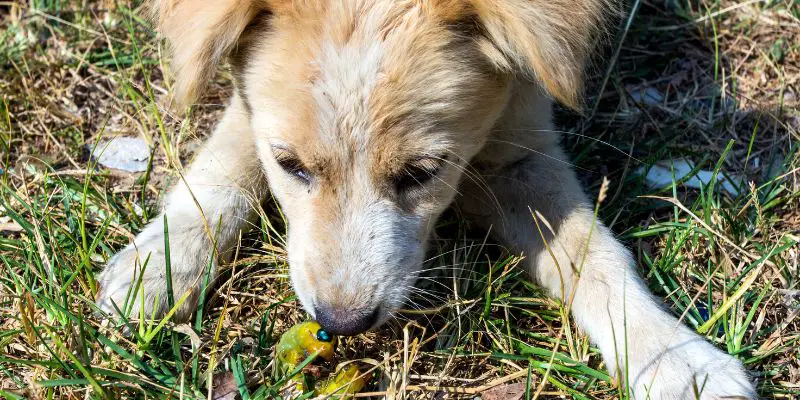For dog parents, mango worm or maggot infestation is one of the worst nightmares. It is contagious and can cause serious health issues for your furry friend. But, how do mango worms get in dogs? Read more.
Do you have a specific question about mango worms in dogs? Then use the table of contents below to jump to the most relevant section. And you can always go back by clicking on the black arrow in the right bottom corner of the page. Also, please note that some of the links in this article may be affiliate links. For more details, check the Disclosure section at the bottom of the page.
Here's what we'll cover:
How do mango worms infect dogs?
Well, they usually come from the environment. For example, if your dog goes out frequently and loves to dig the soil, it will have a higher chance of mango fly infestation. Mango worms, the larvae of the mango fly, may come inside your dog’s body from outside. The mango flies lay their eggs in dirty soil. The eggs get attached to the dog’s fur as they come in contact with it. The eggs then hatch, and the larvae come out. The larvae go under the dog’s skin and on the tissue till these become mature mango flies. The flies then come out of the dog’s skin.
Since the mango larvae infestation is not painful, your dog may not even realize they have mango worms. The larvae take three to four weeks to mature. When they are ready to come out, infected dogs’ skin usually develops red bumps. The bumps or boils then erupt, and a fully-grown mango fly emerges and continues to live on the dog’s skin.
Suppose mango worm infestation is not treated on time. In that case, the dog may become a permanent living place for hundreds of mango flies. Hence you must take the dog to the vet as soon as you find out it has a mango worm infestation.
Symptoms of mango worm infestation in dogs
It is challenging to notice mango worms as the way these worms enter a dog’s skin is painless. Hence, initially, a dog may not display any visible symptoms. But, as time passes, your dog may start to show symptoms. In general, the symptoms appear after two or three weeks of infestation.
Some common symptoms are:
- Strange behavior of the dog
- The dog bites and scratches its skin more than often and frequently
- Red pimple-like growths or boils on the dog’s skin
- Fever
- Blisters
- Difficulty in sleeping
- Weight loss
What to do when you find your dog has mango worms?
Now that you know “how do mango worms get in dogs” if you have an assumption that your dog probably has mango worms, always visit the vet as soon as possible. Because mango flies are contagious and may even infect humans sometimes. Besides that, it can also cause serious health issues for your pet.
First, get an appointment with the vet. The vet will examine and proceed with the treatment. Here are the common treatment methods to cure mango larvae infestation in dogs –
Injection
The vet may recommend an injection to cure the worm infestation. This injection often contains epinephrine and lidocaine that kills the mango larvae effectively.
Suffocating the larvae
In some cases, the vet may decide to suffocate the larvae manually. The vet takes scabs from each boil or blister in this case. Then they will put sterile wax or jelly on the blisters to suffocate the larvae. The vet may then take out each manually.
Popping the boils
It is probably the most used method. The vet simply squeezes the boils to open them, takes out each maggot with a tweezer, and collects them in a separate container. The larvae are then killed to prevent any other incident of infection.
What to do to prevent mango worm infestation in dogs?
As you can see, mango worm infestation in dogs is a serious issue. So, it is better to ensure prevention. Here is what you can do to prevent mango from an infestation in your dog-
● First, avoid letting your dog loose in the world, especially the areas with dirty soil. Such places are often breeding grounds for mango worm eggs or larvae.
● Besides that, give your dog regular grooming and bathe them regularly to clean away any possible eggs of mango worms inside their body. While bathing, scrub their fur. Grooming them also decreases the chance of mango larvae infestation.
Mango larva infestation is common in dogs that often play out in soil and dirt. The worm infestation can be painful for dogs and must be prevented at any cost. As a responsible parent, you must know “how do mango worms get in dogs” and ensure your dog does not get mango worms.
Thanks for the blog graphics: Canva.com

Thanks for the blog graphics: Canva.com
Doghint.com is a participant of several affiliate programs. The list includes (but not limited to) the following: VigLink, Refersion, ShareASale, and Amazon Services LLC Associates Program, an affiliate advertising program designed to provide a mean for us to earn fees by linking to Amazon.com and affiliated sites. Doghint.com does not intend to provide veterinary advice. All published articles are meant for informational purposes only and not substitute the professional veterinary consultation.


